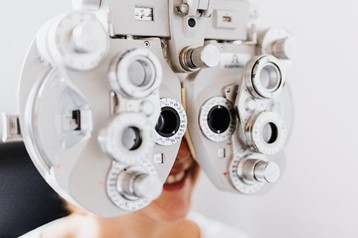- Prescription blue light glasses
- Digital eye strain – Written by Deborah Emmanuel Seah Qing En, BSc (Hons), MSc.
- What is digital eye strain?

- Digital eye strain (DES) is the term used for a variety of eye conditions and vision-related symptoms linked to the prolonged use of digital devices such as mobile phones, tablets and, computers. It is also known as computer vision syndrome (CVS) and visual fatigue (VF).
- The following sections will briefly outline the public health implications of DES, what causes DES, its signs and symptoms, and some insights into its management and treatment.

- The rise of the digital age
- To understand the causes and symptoms of DES, we need to first look at how our growing dependency for digital devices is affecting us all.
- A recent report released in April 2021 found that there are currently 4.72 billion active internet users across the world, accounting for more than 60% of the global population [1].
- The same report also showed that an internet user between the ages of 16 and 64 years spent close to 7 hours each day online [1]. This translates to an average person spending more than 40% of their waking hours on the internet. (Find out how much time you will spend on your smartphone and tablet over your lifetime here)
- We rely on the internet for many aspects of our lives nowadays, from searching for a cooking recipe to staying connected with friends and family through social media. Internet access is also easily available through a variety of digital devices, such as mobile phones, tablets, and computers. The need for the internet in our daily lives will no doubt increase our time spent on these digital devices. Moreover, this inevitable increase in digital device use affects people of all age groups across many developed and developing nations.

- Device use in the adult population
- A study in the United Kingdom (UK) showed that adults over the age of 18 years spent an average of 4 hours 45 minutes a day on digital devices [2]. Similar results were found in the United States (US) where 67% of adults aged 30 years or older used their digital devices for 5 or more hours each day [3]. The same US-based study also reported that even amongst those aged over 60 years old, there has been an eagerness to adopt technology in their daily lives, with 37% of people in this age group spending 5 or more hours on a digital device daily [3].
- Device use in children
- The rise in digital device use is also seen amongst the younger age groups. In the US, it was reported that 65% of children under the age of 18 years spent 2 or more hours on a digital device daily [3]. Similarly, a study conducted on children from 4 European countries (England, Greece, Malta, and Luxemburg) reported that 68% of 3-year-olds were engaging in digital device screen-based activities for an hour each day [4].
- The rapid growth of digital device use seen over the past decade among people from all age groups may further increase their risk of developing DES.
- How many people suffer from digital eye strain?
- DES is a global problem that affects people of every age group, gender, and nationality.
- Digital eye strain in the adult population
- A US-based survey conducted on 10,000 adults found that almost 3 in 4 American adults in their 20s reported symptoms of DES and more than 90% of those in their 30s are at risk of DES after spending 2 or more hours a day using digital devices [3].
- The report also found that more than 60% of adults in their 40s to 50s experience 1 or more symptoms of DES. Adults in their 60s were no exception, with more than 50% found to be experiencing symptoms of DES.

- Digital eye strain in children
- Children born into this digital age are raised with digital devices playing an important role in their daily lives. In most cases, they are not sufficiently informed on how to develop healthy relationships with their digital devices in order to keep themselves safe online and their eyes healthy. A study conducted in India on students aged 11 to 17 years found that 1 in 5 students reported symptoms of DES, with more than 40% of those with DES spending 2 to 4 hours on a digital device daily [5].

- What causes digital eye strain?
- DES is caused by a number of different factors linked to the excessive use of digital devices. Some of these factors include the length of duration spent in front of a digital device screen, the working distance between digital devices to the eyes, the number of times a digital device is used in a day, and even the number of digital devices being used at the same time. The light intensity in the surrounding working environment is also an important factor that contributes to the development of DES.

- Effect of prolonged screen time
- Spending 2 or more hours in front of a digital device screen each day has been found to reduce the number of blinks per minute (blink rate). The act of blinking helps to keep the front surface of the eye moist and clears any particles that may be stuck in the eyes. A lower blink rate is found to be linked to dry eye, which is a common symptom of DES. The average person blinks about 15 times each minute, and studies have shown that this number could decrease by 60% to 6 times per minute when a person uses digital devices [6].
- Effect of the number of digital devices being used at the same time
- The number of digital devices being used at the same time may also contribute to DES. A study conducted in the US found that nearly 8 in 10 Americans who suffer from DES regularly use 2 or more digital devices at the same time [3]. This is particularly concerning considering that in countries such as Singapore, the average adult owns about 3.3 digital devices [7].
- Effect of working angle and distance
- The angle and distance from which a digital device screen is being viewed may lead to symptoms of DES. Desktop computer screens are usually viewed with a horizontal gaze. This will cause the eyes to open wider as compared to viewing a mobile phone or tablet, which is usually viewed with a downward gaze. The wider exposed front surface of the eye may cause evaporation of the tear film, resulting in dry eye, a common symptom of DES [8].
- The distance at which a digital device is being viewed at may also lead to symptoms of DES, especially if the device is held too close to the eyes. When viewing objects that are very near to the eyes, the ciliary muscles (the muscles that change the shape of the lens of the eye to help focus incoming light) will contract. Staring too close to a digital device screen for longer than 2 hours each day may cause the ciliary muscles to contract for an extended period of time, resulting in eye strain, which is also a common symptom of DES [9].
- Effect of the amount of light in the surrounding working environment
- When using a digital device in a working environment where the light is too bright, the light from the surrounding environment will compete with the light coming from the digital device screen, making it too harsh for the eyes. The exposure to this harsh light for extended periods may lead to eye strain.
- Viewing a digital screen in an environment with not enough light may also cause added strain to the eyes. Under dim light, the pupil (the black circle in the centre part of the eye) increases in size so that sufficient light enters the eye, allowing the person to see better. Spending an extended time working under dim light may cause increased strain to the eyes, resulting in symptoms of DES.
- Glare from a digital device screen is also a contributing factor for DES. In 2019, a study conducted in Taiwan found that adults (aged 20-35 years) who were exposed to a glare-free environment demonstrated fewer symptoms of tired eyes and better results when performing eye-related tasks as compared to participants in a high glare environment [10].
- What are the common symptoms of digital eye strain?
- According to the American Optometric Association, the common symptoms of DES include:
- Blurred vision
- Eye strain (Asthenopia)
- Headaches
- Dry eyes
- Neck and shoulder pain
- Other reported symptoms of DES include:
- Eye discomfort
- Difficulty refocusing the eyes from near to distant objects and from distant to near objects
- Irritation of the eye
- Sensitivity to bright lights

- The symptoms of DES are divided into two categories, those that are linked to the function of the eye that allows it to focus light (accommodation) and those linked to dry eye.
- Symptoms linked to the eyes’ focusing ability tend to be the ones that are felt internally, such as headaches, blurred vision, difficulty refocusing the eyes, and eye strain.
- Symptoms linked to dry eye tend to be those that affect the external areas of the eye, such as eye dryness, irritation, and discomfort.
- If you experience any of these signs and symptoms, schedule an appointment with an eye health professional to get your eyes checked. It is also important to note that the development of eye conditions may even start before symptoms appear, which makes going for regular and timely eye checks that much more essential.
- How is digital eye strain diagnosed?
- DES is diagnosed by an eye health professional and can be identified through validated questionnaires and objective assessments of the number of blinks per minute or the ability of the eye to refocus to near and distant objects.

- Questionnaires that are commonly used for diagnosis include:
- Six-item visual fatigue scale
- This questionnaire administered by an eye health professional will require the participant to respond to a few statements regarding visual fatigue. Responses are then gathered on a Likert scale – a points system. The scale includes; difficulties seeing, strange feeling around your eyes, eyes feeling tired, eyes feeling numb, having a headache, and feeling dizzy looking at the screen [11].
- Rasch-based computer-vision symptom scale (CVSS17) [12]
- This questionnaire was created to understand the extent and geographical distribution of the eye-related symptoms with digital device use. Originally published in Spanish, the questionnaire is also now available online in Italian and English. The questionnaire has since been validated for use to measure computer-related visual and ocular symptoms in adults [13].
- Self-administered computer vision syndrome questionnaire (CVS-Q)
- The CVS-Q questionnaire is used to determine the frequency and severity of 16 DES-related symptoms. A score is calculated for each symptom to measure its frequency and severity, with a higher score indicating a higher severity. A person is considered as having DES if the final score is more than or equal to 6. CVS-Q has been validated as a reliable tool to measure DES in computer workers [14].
- In addition to the 3 questionnaires above, some of the other ways to diagnose DES include:
- Measuring blink rate
- A person suffering from DES has been observed to have a lower-than-average blink rate (from an average of 15 times per minute to only 6 times per minute). Blink rate can be measured by manually counting the number of blinks over a period of time intervals from a video recording [15]. Automated software has also been developed to detect the number of eye blinks and has been found to be able to accurately count the number of blinks per minute when compared to manual methods [16].
- Testing the accommodative function of the eye and pupil characteristics
- Accommodation of the eye refers to the ability of the eyes to focus on near and far objects. Pupil characteristics determine how the eye responds to the amount of light in the environment. The speed, accuracy, and amount of pupil reaction to bright or dim light conditions are important factors to produce clear vision.
- An eye health professional may test the accommodative function of the eye and the pupil characteristics when diagnosing DES. To test the eyes’ accommodative function, an accommodative facility test (done over 1 minute, with lenses to stimulate and relax the eyes’ focussing ability) and amplitude of accommodation test (quick and simple test with results matched according to the standard values according to the patient’s age) are conducted. To test pupil characteristics, a quick test using a pen torch to check the speed, amount, and consistency of the pupil’s reaction to dim or bright is done and compared to the standard values.
- How is digital eye strain treated?
- After DES has been diagnosed by an eye health professional, there are a few different methods that could be used to treat the condition. The type of treatment would depend on the symptoms experienced and the severity of the condition.

- Several treatment strategies of DES include:
- Eyeglasses to correct any underlying refractive errors
- Some people who have difficulty seeing near or far objects could have a refractive error. Getting or updating prescription eyeglasses to correct refractive errors such as near-sightedness (myopia), far-sightedness (hypermetropia) or astigmatism may help reduce eye strain, a common symptom of DES.
- Eyeglasses with special lenses
- Special lenses with tints or coatings may help block out some harmful light emitted by digital device screens and allow visual comfort for the user. There are a number of light-blocking filters that claim to help reduce the symptoms of DES. However, it should be noted that the clinical evidence supporting the effectiveness of these filters to treat or prevent DES is still emerging [17].
- Lubricating eye drops
- The use of lubricating eye drops helps to create artificial tears and relieve symptoms of DES related to dry eye. These eye drops work by maintaining the oil layer within the tear film of the eye, which reduces tear evaporation and therefore prevents dry eye.
- How do I manage digital eye strain? Can I prevent it?
- In this digital age, it is unlikely that we will stop using digital devices. Therefore, it is important to build healthy relationships with our digital devices to ensure that our eyes are still well protected while we continue to enjoy the many benefits from these devices.
- A growing body of research is beginning to show that lifestyle interventions may help manage and prevent DES. These lifestyle interventions include:
- Taking regular eye breaks from using digital devices
- Working in front of the computer or using other digital devices continuously for long hours may cause DES. It is recommended by the American Optometric Association to follow the 20-20-20 strategy to prevent DES. The strategy involves taking a break every 20 minutes for 20 seconds to look at an object 20 feet (or about 6 metres) away to help the eyes refocus and relax.

- Engaging in more device-free and outdoor activities
- It is recommended that children spend 2 to 3 hours outdoors each day to maintain good eye health. This may also reduce their risk of developing myopia.
- Reducing discomfort from blue light and glare
- Digital devices are known to emit blue light from its screens, which has been linked to the development of DES in some studies. Using special filters or coatings while looking at a digital device screen may help reduce the exposure of blue light on the eyes, thereby preventing DES.
- Glare from digital device screens may also increase the strain and discomfort on the eyes. Therefore, minimizing glare from a digital device screen by using a glare reduction filter or matte screens instead of glossy screens may help prevent DES. It is also important to adjust the location of the screen to a comfortable position away from light sources that may cause excessive reflection and glare on the screens.
- Ensuring a comfortable work space
- Keeping digital device screens at a comfortable angle and a good distance away from the eyes can may help prevent DES. The American Optometric Association recommends that the digital screens should be placed 15 to 20 degrees below eye level to reduce the risks of developing dry eye-related symptoms of DES.
- The minimum viewing distances when using digital devices differ depending on the type of digital device being used. While using mobile phones and tablets, a minimum distance of 30 centimetres away from the eyes is recommended. For computer screens, the minimum viewing distance ranges from 50 to 60 centimetres depending on the size of the computer screen [7]. The larger the computer screen is, the further the minimum viewing distance should be.
- Remembering to blink
- Dry eye is a common symptom of DES and may be a result of reduced blink rates during prolonged digital device use. Remembering to blink frequently to keep the front surface of the eyes moist and clean may help reduce the risk of developing dry-eye related symptoms of DES.
- DISCLAIMER: THIS WEBSITE DOES NOT PROVIDE MEDICAL ADVICE
.jpeg)
.jpeg)
.jpeg)

.jpeg)
.jpeg)
.jpeg)
.jpeg)
Comments
Post a Comment